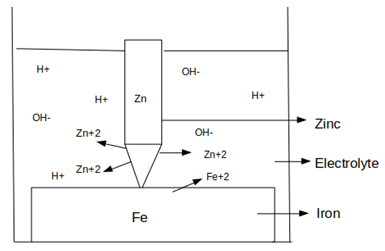This set of Corrosion Engineering Interview Questions and Answers for Experienced people focuses on “Eight Forms – Galvanic Corrosion – 2”.
1. The reason for the noble nature of titanium is that it cathodically polarizes readily in seawater.
a) False
b) True
View Answer
Explanation: Titanium is one of the noble metals in the galvanic series and the reason is that it cathodically polarizes readily in seawater. It replaces many materials as best corrosive resistant metal in the seawater applications and high-velocity corrosive solutions.
2. Corrosion is greater near the seashore than in a dry rural atmosphere.
a) True
b) False
View Answer
Explanation: Corrosion occurs due to the presence of oxygen and moisture (electrolyte). The electrical conductivity of the electrolyte is one of the factors of corrosion. Corrosion increases with an increase in electrical conductivity of the electrolyte. Moisture with salt content relatively has high electrical conductivity, hence corrosion is greater at the seashore.
3. Define the distance effect regarding galvanic corrosion?
a) Corrosion occurs only at the junction of two metals
b) Corrosion occurs only at the edges of two metals
c) Corrosion decreases with increase in distance from the junction
d) Corrosion increases with increase in distance from the junction
View Answer
Explanation: The galvanic effect is the potential difference formed between two or more metals at its junction. It decreases on moving away from the junction. Hence corrosion decreases with an increase in distance from the junction.
4. Define area effect regarding galvanic corrosion?
a) cathodic area * anodic area
b) anodic area/cathodic area
c) cathodic area/anodic area
d) cathodic area + anodic area
View Answer
Explanation: It is the ratio of cathodic to anodic areas. An unfavorable area ratio with a large cathodic area and small anodic area results in high current density at the anode. The greater the current density at an anodic area the greater the corrosion rate.
5. Which of the following is/are the preventions of galvanic corrosion?
a) Avoid the unfavorable area effect of a small anode and large cathode
b) Select the close combination of metals in galvanic series
c) Select the far combination of metals in galvanic series
d) Avoid the unfavorable area effect of a small anode and large cathode and select the close combination of metals in galvanic series
View Answer
Explanation: In industrial applications avoiding a dissimilar metal combination is impossible. But it can be minimized by avoiding the unfavorable area effect, selecting the close combination of metals. Proper material selection and regular inspection are other preventive measures.
6. Which of the following principle is utilized in the concept of cathodic protection?
a) Principle of galvanic corrosion
b) Principle of crevice corrosion
c) Principle of pitting corrosion
d) Principle of selective leaching
View Answer
Explanation: Cathodic protection is a protection of a base structure metal by making it as a cathode. It can be protected by the use of sacrificial anode. The order of metals in the galvanic series is the basis for cathodic protection.
7. Which of the following is an example of cathodic protection?
a) Electroplating of steel
b) Galvanization of steel
c) Magnesium connected to steel pipes
d) Electroplating of steel, galvanization of steel and magnesium connected to steel
View Answer
Explanation: Electroplating and galvanization are cathodic protections of steel based on the galvanic effect. If steel under zinc or other metal coating exposed to corrosive atmosphere, zinc corrodes preferentially than steel. Magnesium acts as a sacrificial anode when it is connected to underground steel pipes.
8. Which of the following are the limitations of the EMF series?
a) Available for metals and alloys
b) Limited to pure metals only
c) Measured only at standard conditions
d) Limited to pure metals and measured only at standard conditions
View Answer
Explanation: EMF series is a list of pure metals arranged according to their electrode potential value measured against SHE. It is measured at standard conditions such as 25°C, 1atm pressure, and 1M concentration of hydrogen ions.
9. Which of the following chemical is responsible for the stains on silver?
a) Hydrogen peroxide
b) Hydrogen sulfide
c) Sulfur dioxide
d) Sulfur trioxide
View Answer
Explanation: The stains on sliver is usually due to the presence of hydrogen sulfide. It can be removed by the application of galvanic corrosion. It can be done with silver-aluminum galvanic attachment in the presence of baking soda.
10. Which of the following type of corrosion is depicted in the given figure?

a) Crevice corrosion
b) Pitting corrosion
c) Galvanic corrosion
d) Erosion corrosion
View Answer
Explanation: Here zinc and iron preferentially act as the anode and cathode respectively. This is the galvanic effect. And zinc corrodes more rapidly and iron gets protected.
Sanfoundry Global Education & Learning Series – Corrosion Engineering.
To practice all areas of Corrosion Engineering for Interviews, here is complete set of 1000+ Multiple Choice Questions and Answers.
If you find a mistake in question / option / answer, kindly take a screenshot and email to [email protected]
- Apply for Metallurgical Engineering Internship
- Practice Metallurgical Engineering MCQs
- Check Metallurgical Engineering Books
- Check Mechanical Engineering Books
- Practice Mechanical Engineering MCQs
